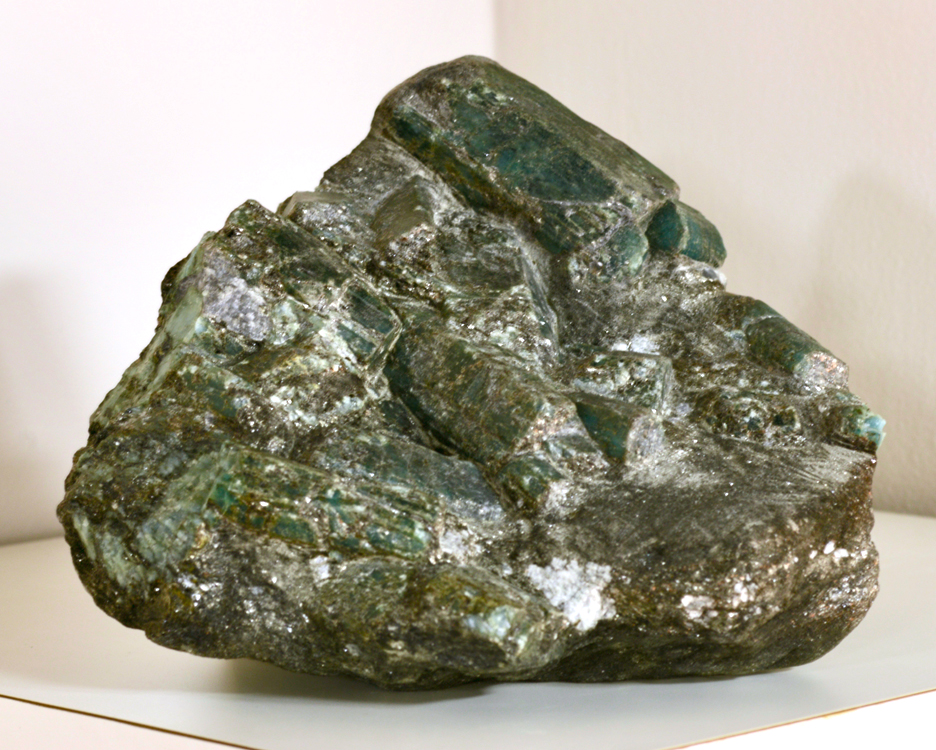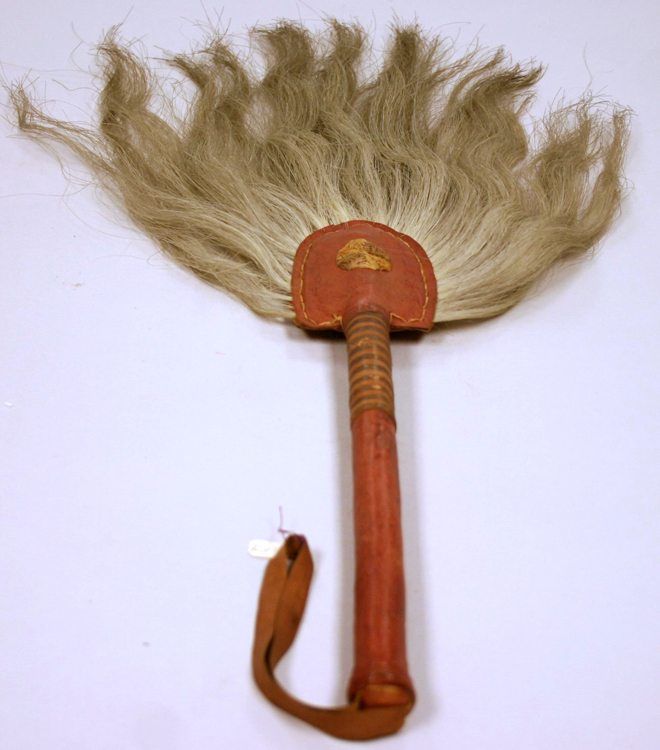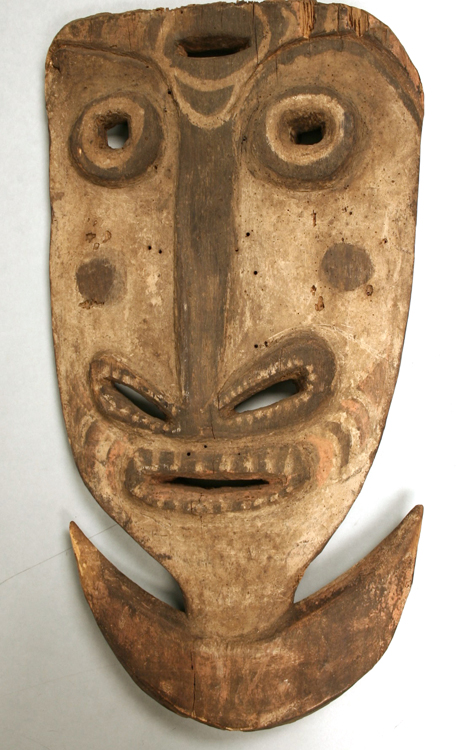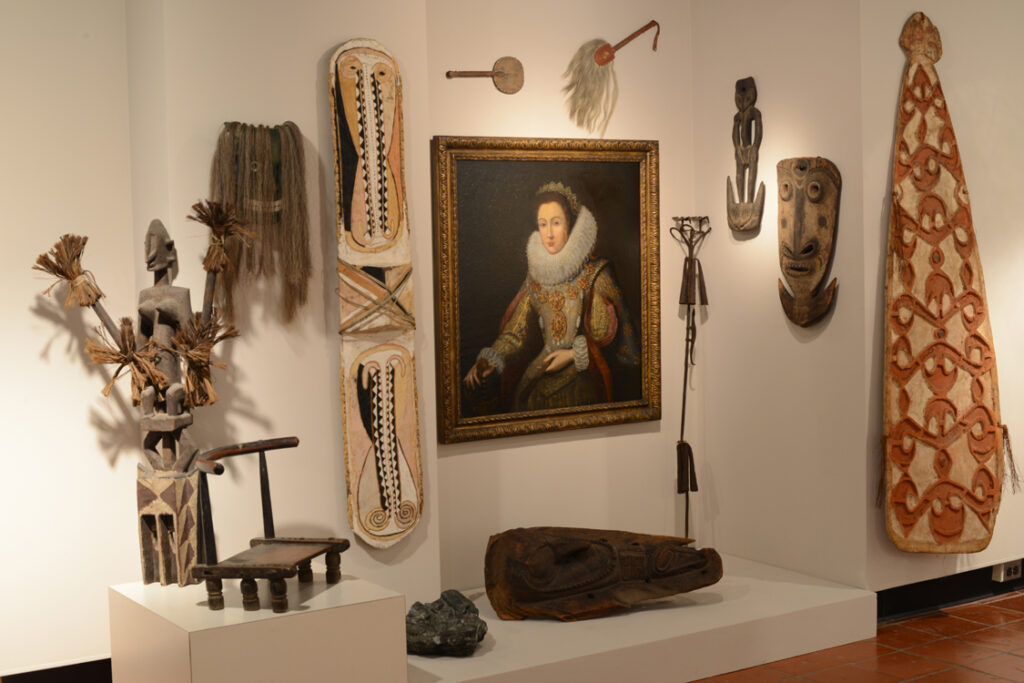
This cabinet symbolizes strength of purpose, royal privilege, and defense against enemies and evil. It is larger than life, as it contains objects of visual grandeur.
Unknown Dogon Artist
Mali, Africa
Satimbe, 20th century
Wood, fiber, paint, 40 3/4 x 18 x 6 inches
Gift of Geneva R. Steinberger
Satimbe masks from Mali are surmounted by a female figure representing the elder sister of the mask. It is a ceremonial mask used during the annual harvest festival (called Bulu), celebrated in all the villages before the rainy season. The rectangular lower portion is surmounted by this standing female figure with outstretched and moveable arms. The figure represents yasigine, the only woman admitted to the Awa male society. These few female members of Awa stand for the collective woman who, in origin stories, first discovered masks.
Unknown Vai Maker
Liberia, Africa
Country Chair, early to mid-20th century
Wood, brass, 15 1/4 x 20 1/4 x 12 inches
Gift of William C. Lickle
The Liberian Vai are known as skilled carpenters, weavers, farmers, and tailors. This chair shows the skill of the Vai carpenter in its bentwood back and the joinery of the seat. “Found” elements are seen in the details, such as the brass tacks and lathe-turned legs and are assimilated into the design. Chairs and stools in many African cultures denote stature, and it is an honor to be able to sit on a seat elevated from the ground.
Elroy Keepness (Kwakwaka’wakw, dates unknown)
Bukwas [Wild Man of the Woods], 1993
Wood, paint, hair (musk ox?), 24 inches (including hair) x 7 1/4 x 6 1/4 inches
Gift of Frederick and Lucy Herman Native American Collection
This object comes from the Pacific Northwest. Bukwas, or Wild Man of the Woods, is a significant supernatural spirit being and casts a haunting figure in the Kwakwaka’wakw great annual winter dance. He resembles a gaunt, haggard, wild man, dressed in ragged garments with long, disheveled hair. He is a small green spirit whose face looks emaciated like a skeleton and has a long curving nose. Bukwas lives in the deep forests and tries to bring the living over to the world of the dead. He is a spirit of the dead identified with an afterlife realm inhabited by various ghosts, especially the souls of those who have drowned.
Unknown Mengen Maker
New Britain, Melanesia
War Shield, early 20th century
Wood, rattan, polychrome, 61 1/8 x 10 7/8 inches
Gift of Cedric H. Marks
The Mengen people live on the south coast of New Britain, near Jaquinot Bay. Their art-making tradition includes producing ceremonial shields made from wood and woven fiber, which were carved in low relief and painted with red, white, and black pigment. Like the Asmat example on view (similar to object 88 in this cabinet), this shield is a war shield, with a triangular carved handle on the back covered in patterned woven rattan.
Emerald
Bahia, Brazil
11 x 12 x 5 inches
Emerald, the green variety of the mineral beryl, was first discovered in Egypt and was mined there as early as 1500 BCE. Cleopatra adorned herself and her palace with emeralds in a display of wealth and power. Emeralds were later discovered by Spanish explorers in the 16th century in what is now Colombia, although the emeralds had been used for jewelry and religious ceremonies by the Incas for 500 years. During their filming of the movie Cleopatra, Richard Burton bought Elizabeth Taylor an emerald brooch, which became one of many that she owned. In 2011, one of her emerald pendants sold at auction for more than six million dollars.
Unknown Iatmul Maker
Papua, New Guinea
Canoe Bowsprit, 20th century
Wood, 30 1/2 x 16 1/2 x 9 inches
Gift of Miss Ingeborg de Beausecq
Crocodiles play a central role in the art and culture of the Iatmul people, who reside in the middle Sepik River region of Papua, New Guinea. According to one Iatmul creation account, an ancestral crocodile was responsible for forming the land. In the beginning, the earth was covered by a primordial ocean. The crocodile dove into the ocean, and when he surfaced, he brought a quantity of mud with him, forming land.
This boat prow was probably from a war or transport canoe, which could hold ten to twenty men, and was hewn from a single log. The crocodile figures prominently on this bowsprit as does the ferocious beaked face representing a revered ancestor figure.
Unknown Bamum/Bamoun Maker
Cameroon, Africa
Scepter, 20th century
Wood, 12 5/8 x 5 1/8 inches
Gift of William C. Lickle
This double-sided, low-relief carved paddle features symbols important to the Bamum/Bamoun people. A double-sided depiction of an ancestral skull is carved at the base of the handle. A spiritual animal, either a chameleon or crocodile, is shown at the joining of the disk and handle.
Unknown Artist
Great Britain, 17th or 18th century
Portrait of Queen Elizabeth I
Oil on canvas 35 3/4 x 31 1/2 inches
Gift of Ellen duPont Wheelwright Estate
Elizabeth I was Queen of England and Ireland from November 17, 1558 until her death on March 24, 1603. Sometimes called the Virgin Queen, Gloriana, or Good Queen Bess, Elizabeth was the last of the five monarchs of the House of Tudor. A cult grew around her and she was celebrated in the portraits, pageants, and literature of the day, and her notoriety has extended to portraits such as this and even to contemporary novels and films.
Unknown Maker
Africa
Flywhisk, 19th-20th century
Leather, animal hair, 27 1/2 x 9 1/2 inches
Gift of the Carpenter Collection
Flywhisks appear frequently in many parts of the African continent. Collection records indicate that this one is probably from East Africa, either from Ethiopia or Kenya. Similar whisks are found among the Zulu in the south and Yoruba in the west. In addition to the practical aspect of shooing away flies, a flywhisk is also a symbol of power and nobility. Horsehair is usually the choice for the whisk, as horses are also symbols of influence and stature. The hair on this whisk may indeed be horsehair, but its softness and fine tresses may indicate another species such as a wildebeest beard.
Unknown Yoruba Artist
Nigeria, Africa
Opa Orere Diviner’s Staff, early 20th century
Iron, 51 7/8 inches high
Gift of Mr. & Mrs. Arnold Saltzman
The opa orere (also called opa osun or opa osungaga) is used by Yoruba babalawos (diviners) as a symbol of office but also as an altar to the divination god Orunmila. During Orunmila ceremonies, the babalawo leads the procession through the village carrying his opa orere. To let the staff fall is to invite the wrath of Orunmila. The babalawo must ensure that the staff remains erect to receive full blessings from the god. When not in use, the staff is stuck into the ground in front of the babalawo’s house and protects the babalawo while he sleeps.
Unknown Maker
New Guinea
Anthropomorphic Suspension Hook, early 20th century
Wood, 22 x 7 3/8 inches
Gift of Alan Gerdau
A suspension hook such as this was probably hung in a men’s tribal house as a sculptural element rather than for a utilitarian purpose. Artists of the Kopar and Angoram people, who live near the mouth of the Sepik River in northern New Guinea, created distinctive openwork figures portraying powerful spirits with long beak-like noses and lithe, attenuated bodies, much like this example.
Unknown Sepik River Maker
Papua, New Guinea
Suspension Hook/Mask, early 20th century
Wood, polychrome, 22 7/8 x 12 1/2 inches
Gift of Mr. Alan Gerdau
Suspension hooks like this one have both utilitarian and ceremonial functions in Papua, New Guinea. Suspended from the rafters by a cord, they are used to safeguard food, clothing, and other items. Baskets or string bags are filled and hung from the hook-shaped prongs at the base to keep them out of reach of vermin. Most hooks are adorned with representations of ancestral spirits and totemic animals associated with the owner’s clan. Given the size and ferocity of this shield-like face, this suspension hook was probably both utilitarian and a protector of the home.
Unknown Asmat Maker
New Guinea
War Shield, early 20th century
Wood, fiber, polychrome, 74 1/4 x 19 1/2 inches
Gift of Mr. Samuel Rubin
The Asmat inhabit a vast swamp on the south coast of the island of New Guinea in the Indonesian province of Papua (also called West Papua, formerly Irian Jaya). Tribal warfare and headhunting historically played an important role in Asmat culture and religion. Shields (jamasj) offer protection from both the physical and spiritual powers of the enemy. Shield motifs, and the ancestor for whom a shield is named, give its owner power. Headhunting symbols are common on many shields, and this shield, for example, features the flying fox in red and white ochre, a symbol associated with headhunting.


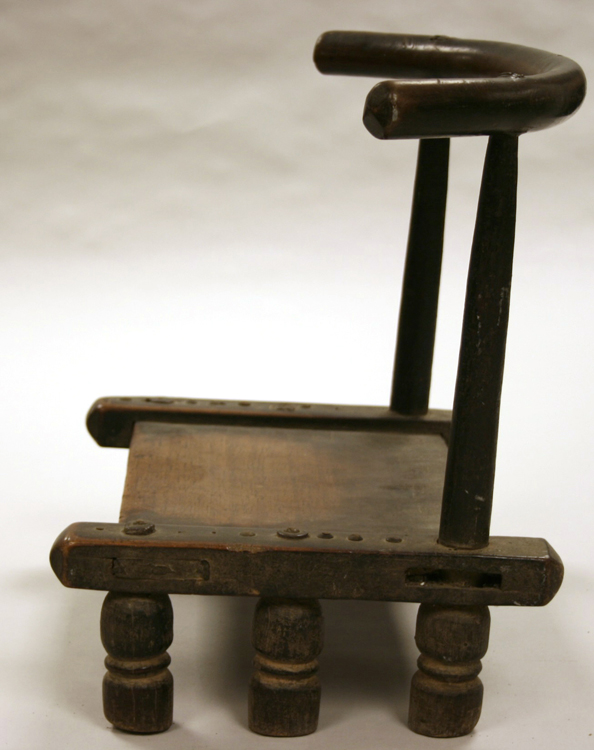
![91 Bukwas [Wild Man of the Woods] 91 Bukwas [Wild Man of the Woods]](https://exhibitions.lib.udel.edu/collectors-cabinet/wp-content/uploads/sites/234/2021/02/091.jpg)

